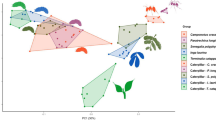Abstract
Laboratory experiments were conducted to study the characteristics of parasitism of diamondback moth,Plutella xylostella (L.), a worldwide pest of crucifers, by a larval parasite,Diadegma semiclausum Hellén. Results showed that the greater the host larval density, the lesser was the percentage of larvae parasitized. The area of discovery decreased with increasing parasite density, but k-value remained practically unchanged. Parasitism reduced food consumption in parasitised larvae. No difference was observed in duration of larval instars between the parasitized and healthy larvae. As the frequency of superparasitism increased, the proportion of production of female progeny also increased. Presence of parasite larva within the host larva deterred superparasitism greater than the presence of parasite egg. Presence of larva of eitherD. semiclausum or another larval parasite,Cotesia plutellae Kurdjumov, within host larva deterred multiparasitism by either species greater than the presence of egg of either parasite species.Diadegma semiclausum was much more aggressive thanC. plutellae in parasitisingP. xylostella larvae.
Résumé
Des expériences ont été menées en laboratoire afin d'étudier les caractéristiques du parasitisme dePlutella xylostella (L.), ravageur des crucifères de répartition mondiale, par un parasitoïde larvaire,Diadegma semiclausum Hellén. Les résultats montrent que plus la densité des larves-hôtes est importante, plus le pourcentage de larves parasitées est faible. La surface explorée décroît avec l'augmentation de la densité du parasitoïde mais la valeur de k est pratiquement invariable. Le parasitisme réduit la consommation alimentaire des chenilles. Aucune différence n'est observée quant à la durée des stades larvaires entre larves parasitées et larves non parasitées. La proportion de femelles augmente avec l'accroissement de la fréquence du superparasitisme. La présence de larves du parasitoïde à l'intérieur de la larve-hôte limite davantage le superparasitisme que la présence d'oeufs du parasitoïde. La présence de larves deD. semiclausum ou d'un autre parasitoïde larvaire,Cotesia plutellae Kurdjumov, à l'intérieur des larves-hôtes freine davantage le multiparasitisme par l'une ou l'autre des espèces que la présence d'oeufs de l'un ou l'autre parasitoïde.D. semiclausum est beaucoup plus aggressive queC. plutellae pour parasiter les larves deP. xylostella.
Similar content being viewed by others
References
Chua, T. H. &Ooi, P. A. C. — 1986. Evaluation of three parasites in the biological control of diamondback moth in the Cameron Highlands, Malaysia. In: Diamondback Moth Management: Proceedings of the First International Workshop, (N. S. Talekar &T. D. Griggs, eds). Asian Vegetable Research and Development Center, Shanhua, Taiwan. p. 173–184.
Hassell, M. P. — 1971. Mutual interference between searching insect parasites. —J. Anim. Ecol., 40, 473–486.
Lim, G. S. — 1982. The biology and effects of parasites on the diamondback moth,Plutella xylostella (L.). Ph. D. thesis, Univ. of London. 317 p.
Lim, G. S. — 1986. Biological control of diamondback moth. In: Diamondback Moth Management: Proceedings of the First International Workshop, (N. S. Talekar &T. D. Griggs, eds). Asian Vegetable Research and Development Center. Shanhua, Taiwan. p. 159–171.
Lloyd, D. C. — 1940. Host selection by hymenopterous parasites of the mothPlutella maculipennis. —Proc. Roy. Soc. Lond. B128, 451–484.
Miyata, T., Saito, T. &Noppun, V. — 1986. Studies on the mechanism of diamondback moth resistance to insecticides. In: Diamondback Moth Management: Proceedings of the First International Workshop, (N. S. Talekar &T. D. Griggs, eds). Asian Vegetable Research and Development Center. Shanhua, Taiwan. p. 347–357.
Mustata, G. — 1987. The parasite complex limitingPlutella maculipennis Curt. (Lepidoptera, Plutellidae) populations in Moldavia (Romania). —Stud. Cercet. Biol. Ser. Biol. Anim., 39, 32–46. (in Rumanian).
Mustata, G. — 1992. Role of parasitoid complex in limiting the population of diamondback moth in Moldavia, Romania. In: Management of Diamondback Moth and Other Crucifer Pests: Proceedings of the Second International Workshop, (N. S. Talekar, ed.). Asian Vegetable Research and Development Center. Shanhua, Taiwan, p. 203–211.
Nicholson, A. J. & Bailey, V. A. — 1935. The balance of animal population, Part 1. —Proc. Zool. Soc. London, 551–598.
Ooi, P. A. C. — 1980. Laboratory studies ofDiadegma cerophaga (Hymenoptera: Ichneumonidae), a parasite introduced to controlPlutella xylostella (Lepidoptera: Hyponomeutidae) in Malaysia. —Entomophaga, 25, 249–259.
Sun, C. N. — 1992. Insecticide resistance in diamondback moth. In: Diamondback Moth and Other Crucifer Pests: Proceedings of the Second International Workshop, (N. S. Talekar, ed.). Asian Vegetable Research and Development Center. Shanhua, Taiwan, p. 419–426.
Talekar, N. S. &Yang, J. C. — 1991. Characteristics of parasitism of diamondback moth by two larval parasites. —Entomophaga, 36, 95–104.
Talekar, N. S., Yang, J. C., Liu, M. Y. &Ong, P. C. — 1990. Use of parasitoids to control the diamondback moth,Plutella xylostella. In: The use of natural enemies to control agricultural pests. (O. Mochida, K. Kiritani &J. Bay-Peterson, eds), Food and Fertilizer Technology Center, Taipei, p. 106–114.
Varley, G. C. &Gradwell, G. R. — 1960. Key factors in population studies. —J. Anim. Ecol., 29, 399–401.
Author information
Authors and Affiliations
Rights and permissions
About this article
Cite this article
Yang, JC., Chu, YI. & Talekar, N.S. Studies on the characteristics of parasitism ofPlutella xylostella (Lep.: Plutellidae) by a larval parasiteDiadegma semiclausum (Hym.: Ichneumonidae) . Entomophaga 39, 397–406 (1994). https://doi.org/10.1007/BF02373045
Received:
Accepted:
Issue Date:
DOI: https://doi.org/10.1007/BF02373045




